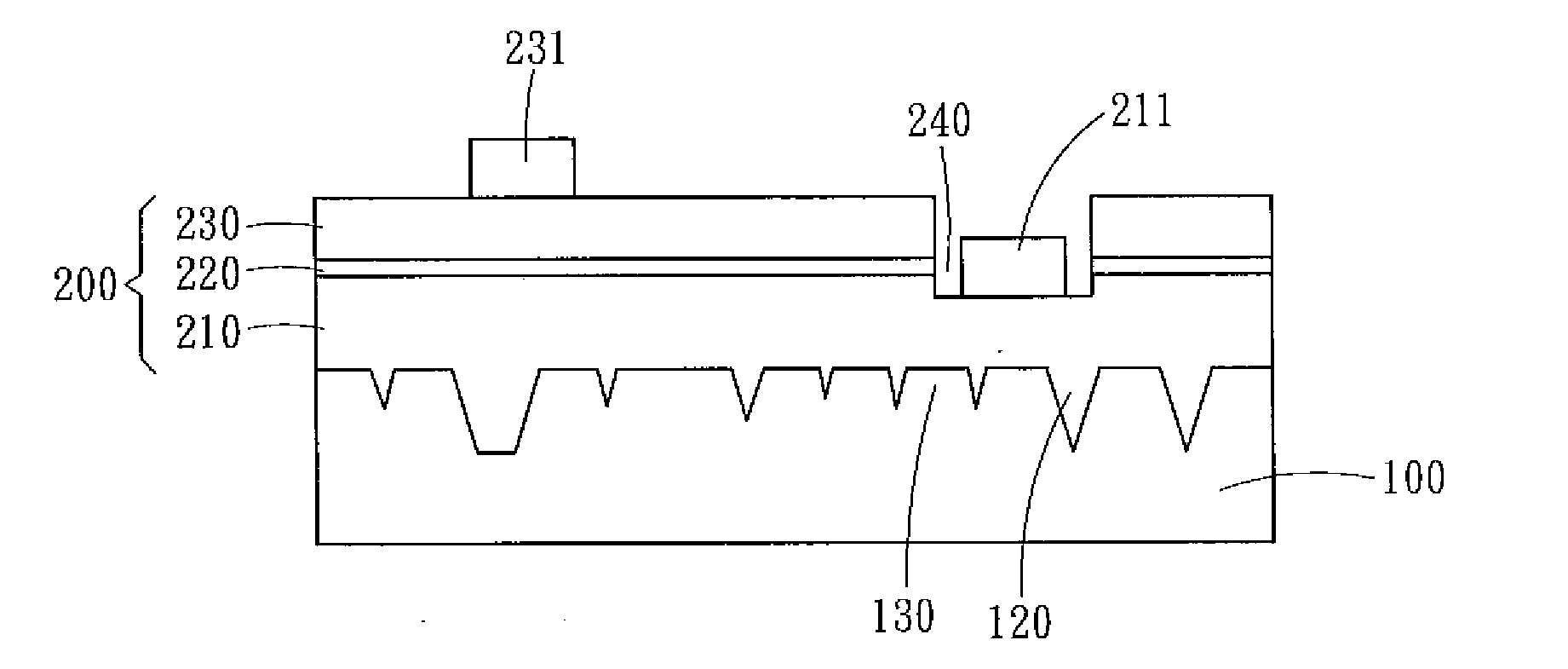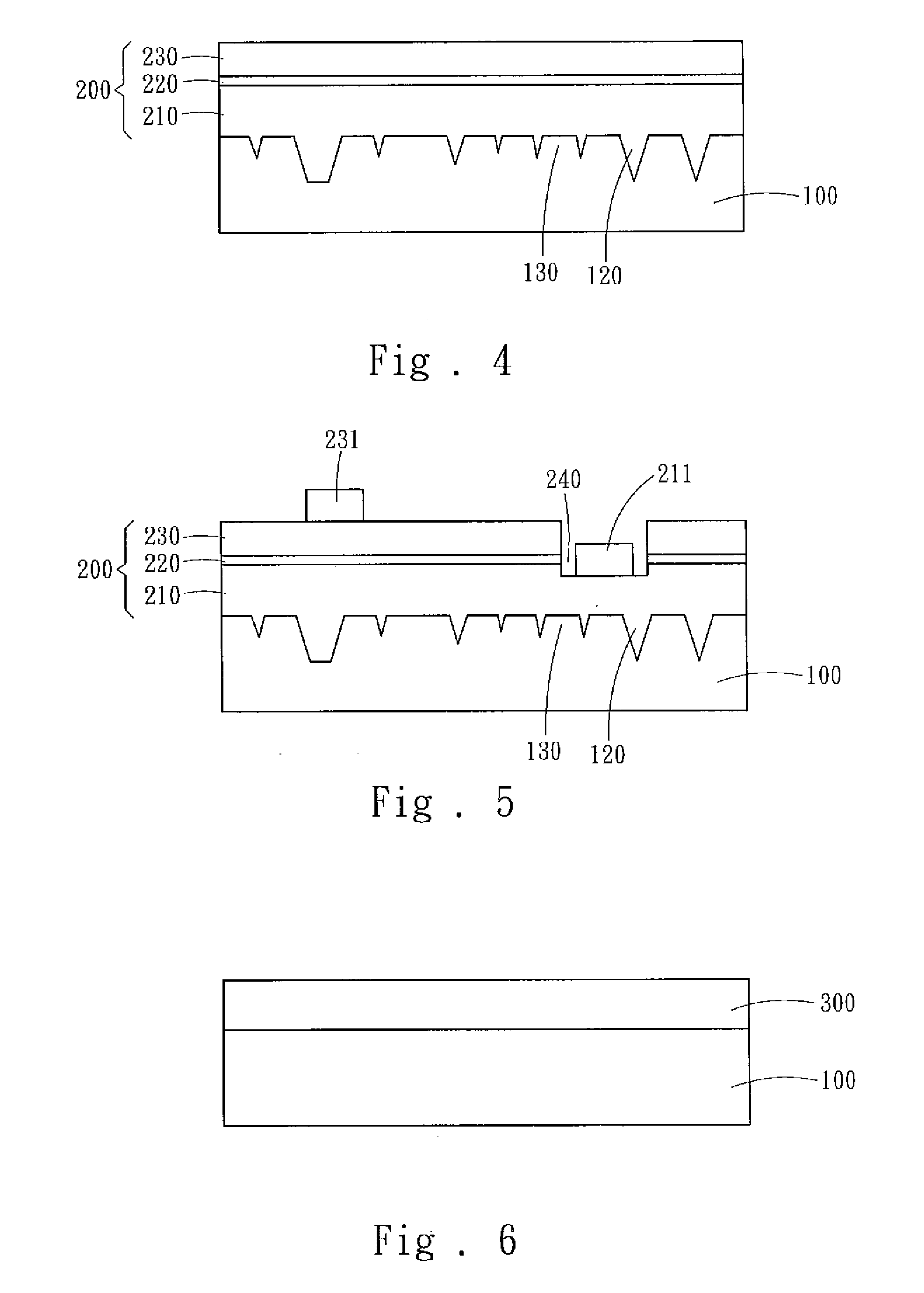Light emitting diode structure and method for fabricating the same
a technology of light-emitting diodes and diodes, which is applied in the direction of semiconductor/solid-state device manufacturing, semiconductor devices, electrical devices, etc., can solve the problems of insufficient light efficiency, complicated process, and inability to meet the requirements of the market, so as to reduce the total reflection, reduce the horizontal light propagation between the substrate and the semiconductor layer, and increase the light extraction efficiency of the led element
- Summary
- Abstract
- Description
- Claims
- Application Information
AI Technical Summary
Benefits of technology
Problems solved by technology
Method used
Image
Examples
embodiment i
[0027]Refer to from FIG. 1 to FIG. 5 diagrams schematically showing a first embodiment of the present invention. The method of the present invention includes providing a substrate 100, as shown in FIG. 1. The substrate 100 may be made of sapphire, silicon carbide, silicon, gallium arsenide, aluminum nitride, or gallium nitride.
[0028]Next, the substrate 100 is placed in a first solution for chemical reaction, and a high-density nanometric chemical reaction layer 110 naturally forms on the surface of the substrate 100. The substrate 100 should be placed in the first solution for from 1 second to 200 minutes. Next, the substrate 100 is selectively etched to form a plurality of concave zones 120 on the substrate 100 without the chemical reaction layer 110 and form a plurality of convex zones 130 having the chemical reaction layer 110 overhead with the chemical reaction layer 110 being a mask and with a dry-etching method, a wet-etching method, or a combination of a dry-etching method an...
embodiment ii
[0036]Refer to from FIG. 6 to FIG. 8 diagrams schematically showing a second embodiment of the present invention. The method of the second embodiment is based on that of the first embodiment, but a pre-treatment is first performed before the substrate 100 is placed in the first solution. The pre-treatment is to grow a passivation layer 300 having a thickness of between 1 Å and 10 μm on the surface of the substrate 100, as shown in FIG. 6. The passivation layer 300 may be a single- or multi-layer structure made of one or more materials selected from the group including: silicon, silicon nitride, silicon oxide, aluminum oxide, metal, photoresist, benzocyclobutene, and polyimide.
[0037]Then, the substrate 100 is placed in the first solution to form a high-density nanometric chemical reaction layer 110 inside the passivation layer 300 on the surface of the substrate 100. Next, the substrate 100 is selectively etched with the passivation layer 300 and the chemical reaction layer 110 being...
embodiment iii
[0039]Refer to from FIG. 9 to FIG. 13 diagrams schematically showing a third embodiment of the present invention. The method of the third embodiment is based on that of the second embodiment, and the pretreatment is also to grow a passivation layer 300 on the surface of the substrate 100, as shown in FIG. 9. Next, the passivation layer 300 is patterned with a photolithographic process to form periodical patterns to expose parts of the surface of the substrate 100, as shown in FIG. 10. The periodical patterns of the passivation layer 300 may be the periodical pattern of circles, polygons, or the combination of them. The width of the periodical pattern is within from 0.1 to 15 μm, and the spacing between the periodical patterns is also within from 0.1 to 15 μm.
[0040]Next, the substrate 100 is placed in the first solution to form a high-density nanometric chemical reaction layer 110 on the exposed surfaces of the substrate 100, as shown in FIG. 11. Next, the substrate 100 is selectivel...
PUM
 Login to View More
Login to View More Abstract
Description
Claims
Application Information
 Login to View More
Login to View More - R&D
- Intellectual Property
- Life Sciences
- Materials
- Tech Scout
- Unparalleled Data Quality
- Higher Quality Content
- 60% Fewer Hallucinations
Browse by: Latest US Patents, China's latest patents, Technical Efficacy Thesaurus, Application Domain, Technology Topic, Popular Technical Reports.
© 2025 PatSnap. All rights reserved.Legal|Privacy policy|Modern Slavery Act Transparency Statement|Sitemap|About US| Contact US: help@patsnap.com



